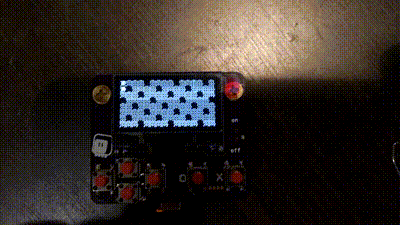Progress on a Game¶
Published on 2018-01-20 in Micro:Boy.
With the hardware finalized, the remaining work is to actually write at least one game, to prove that it’s possible. I decided to make a game inspired by such classics as Dig Dug, Digger and Boulder Dash — you dig tunnels, collect gems, avoid monsters and drop boulders on them. So far I have the basic graphics and the player animation:

———- more ———-The code for the display got a bit simplified, and merged with the code for buttons. I also added a “tick” function for keeping a constant frame rate.
import microbit
DIRT = b'\x8a \x05P\x05 \x8a '
DARK = b'\x00\x00\x00\x00\x00\x00\x00\x00'
ROCK_MASK = b'<~\xff\xff\xff\xff~<'
ROCK = b'\x004Z>V*\x14\x00'
GEM = b'\x00\x18,N\x02\x04\x08\x00'
MAN_MASK = b'0\xfe\xff\xff\xff\xff\xfe0'
MAN = (b'\x00\x10z>:~ \x00', b'\x00 \x1a~z>\x10\x00')
class Console:
_command = bytearray(b'\x00\xb0\x02\x10')
def __init__(self):
self.next_frame = microbit.running_time() + 100
self.buffer = bytearray(1024)
self.dirty_min = bytearray([0] * 8)
self.dirty_max = bytearray([128] * 8)
microbit.i2c.init(freq=400000, scl=microbit.pin2, sda=microbit.pin1)
try:
microbit.i2c.write(0x3c, b'')
except OSError:
pass
_init = (b'\x00\xae\xd5\x80\xa8\x3f\xd3\x00\x40\x80\x14'
b'\x20\x00\xa1\xc8\xa1\xda\x12\x81\xcf\xd9\xf1'
b'\xdb\x40\xa4\xa6\xaf')
microbit.i2c.write(0x3c, _init)
@staticmethod
def buttons():
return microbit.i2c.read(0x10, 1)[0]
def tick(self, ms=100):
delay = self.next_frame - microbit.running_time()
if delay > 0:
microbit.sleep(delay)
self.next_frame += ms
def update(self):
buf = self.buffer
index = 0
for page in range(8):
dmin = self.dirty_min[page]
dmax = self.dirty_max[page]
if dmax:
self._command[1] = 0xb0 | page
self._command[2] = 0x00 | ((2 + dmin) & 0x0f)
self._command[3] = 0x10 | ((2 + dmin) >> 4) & 0x0f
microbit.i2c.write(0x3c, self._command)
microbit.i2c.write(0x3c,
b'\x40' + buf[index + dmin:index + dmax])
index += 128
self.dirty_max[page] = 0
self.dirty_min[page] = 127
def blit(self, x, y, data, mask=b''):
if not -8 < x < 128:
return
if x < 0:
data = data[-x:]
x = 0
elif x > 120:
data = data[:120 - x]
page = y // 8
shift = y % 8
if 0 <= page <= 7:
index = x + 128 * page
for byte in mask:
self.buffer[index] &= ~(byte << shift)
index += 1
index = x + 128 * page
for byte in data:
self.buffer[index] ^= byte << shift
index += 1
self.dirty_min[page] = min(self.dirty_min[page], x)
self.dirty_max[page] = max(self.dirty_max[page], x + 8)
page += 1
if 0 <= page <= 7 and shift:
shift = 8 - shift
index = x + 128 * page
for byte in mask:
self.buffer[index] &= ~(byte >> shift)
index += 1
index = x + 128 * page
for byte in data:
self.buffer[index] ^= byte >> shift
index += 1
self.dirty_min[page] = min(self.dirty_min[page], x)
self.dirty_max[page] = max(self.dirty_max[page], x + 8)
console = Console()
for y in range(8):
for x in range(16):
if (x + 3 * y + 1) % 5:
console.blit(x * 8, y * 8, DIRT)
console.blit(0, 0, ROCK, ROCK_MASK)
console.blit(0, 16, GEM, ROCK_MASK)
frame = 0
facing = 1
x = 0
y = 8
while True:
frame = (frame + 1) % 4
buttons = console.buttons()
if buttons & 4:
x += 1
facing = 1
elif buttons & 16:
x -= 1
facing = -1
man = MAN[frame // 2]
if facing > 0:
man = reversed(man)
console.blit(x, y, man, MAN_MASK)
console.update()
console.blit(x, y, DARK, MAN_MASK)
console.tick(50)
You can also see how you can easily mirror the sprites by calling “reversed” on their data.
 deshipu.art
deshipu.art